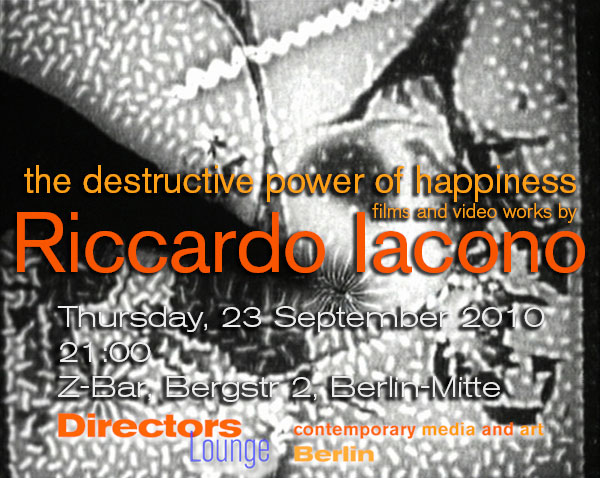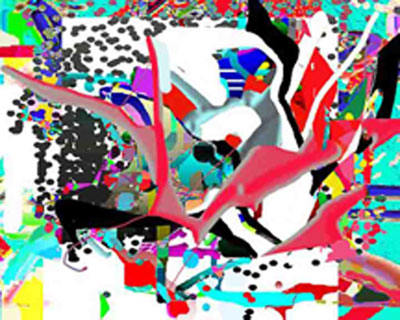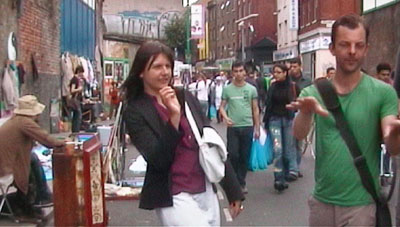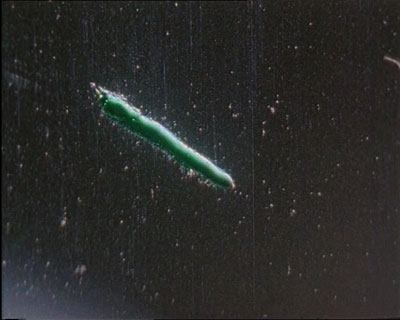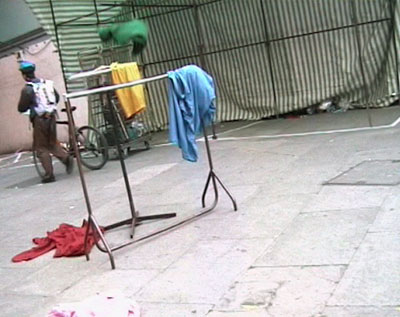 |
directors lounge monthly screenings
the destructive power of happiness
video and film works by
riccardo iacono
Donnerstag, 23. September 2010
21:00 Uhr
Z-Bar
Bergstraße 2
10115 Berlin-Mitte
riccardo iacono
the destructive power of happiness
(die destruktive macht des glücks)
Riccardo Iacono
The Destructive Power of Happiness
(Die destruktive Macht des Glück)
Riccard Iacono, Künstler und Filmemacher aus Londen, präsentiert eine Auswahl seiner Filme aus drei Werkperioden: Abstrakte Videos, hand-gemalter Film und „Shooqui” eine Serie von Videoperformance Tapes.
„Der Programmname hat nichts mit den gezeigten Filmen zu tun, ich fand ihn einfach interessant” (R.I.) Was, so ausgedrückt, schon eine Qualität seiner Arbeiten aufzeigt. Mit leichtem Sarkasmus versucht Riccardo schnellen Vorurteilen mit konträren Strategien entgegenzutreten. Der Künstler, der ursprünglich Malerei studierte (Glasgow School of Art) fand seinen Weg zum 16mm Film durch den Umweg über Videoprojekte mit zeitgenössischen Komponisten der Musique Concrète und für Rave-Projekte.
„Ein großer Einfluß auf mein früher Werk war das Buch ‚Electronic Revolution‘ von William Bourroughs, das elektronische Aufzeichnungen, Loops und Feedback dahingehend bespricht, wie diese Unruhen anstiften oder diese eskalieren lassen könnten.”… „Nach einer Fernsehsendung mit Stan Brakhage und Pat O‘Neil Filmen las ich Brakhages Schriften”, aber es gab damals, Ende der 80er fast keine Möglichkeiten solche künstlerischen Bildfilme in Glasgow zu sehen; noch wurden sie im Duncan of Jordanstone College of Art in Dundee besprochen, als Riccardo zehn Jahre später das Department of Electronic Imaging besuchte.
In seinem Arbeitsprozess mit 16mm Film wird der handbemalte Film selbst zur Partitur des Filmemachens, d.h. für das Abfilmen des „Originals”. Mit der optischen Bank (Optical Printer) entwickelte er eine Möglichkeit, das von der reliefartigen Farboberfläche reflektierende Licht aufzunehmen und gleichzeitig den Film von hinten zu beleuchten (wie es traditionell geschieht). Obwohl solche Animationstechniken viel Geduld erfordern, erreichte Riccardo mit seiner Technik schon eine Art improvisierter Direktheit beim Kopieren von Film zu Film. Dieses Verlangen nach Unmittelbarkeit und Improvisation, und vielleicht nach mehr Kontakt zu Menschen im Prozess führte ihn zu den jüngsten Arbeiten: „Shooqui” ist eine Videoserie, in der es um das Werfen von Erbsen oder von Kleidung geht — und die gerade das Gegenteil von kameralosen Film darstellt. Der Künstler hält mit einer Hand die Kamera und zielt auf die voraussichtliche Fluglinie des Objektes, das er mit der anderen Hand wirft. Die körperliche Verbindung zwischen Kamera und Bewegung führt zu einer eruptiven und zirkulären Bewegung der Kamera, wenn schwerere Objekte wie z.B. nasse Kleidungsstücke geworfen werden. „Es ist fast wie der Rückstoß beim Feuern eines Gewehrs.”
Das Werfen von Erbsen, diese scheinbar nette, naiv-unschuldige Handlung zeigt jedoch durchaus aggressive Züge, einmal in der insistierenden Geste selbst und zweitens auf der Ebene des Bildes. Wir sehen eine Art Missachtung des Kamerabildes. Die sehr kleinen Erbsen ergeben nicht wirklich ein Bild, die Flugbahn ist fast unsichtbar und so lässt die Kamera den Betrachter auf das Wurfziel starren: Fenster, Mauern, Kartonagen, oder Feuerhydranten. Andererseits provoziert das Filmen von Erbsen im Flug offensichtlich direkte öffentliche Reaktionen. Die Leute befragen den Filmemacher kritisch, und die gegebene Antwort, z.B. dass der Künstler den „Sound von Erbsen aufnimmt” erscheint weniger plausibel zu sein, als die Unterstellung es wäre ein eigenartiger Kink, oder Fetisch, des Künstlers („Kinky”).
Obwohl er sich um Unmittelbarkeit bemüht, hat Riccardo Iacono bisher keine VJ-Software benutzt, um seine abstrakten Videos zu machen. Die Bilder werden digital generiert und oft Frame für Frame gegenübergestellt, was in „Play” soweit führt, dass Komplementärfarb- und räumliche Effekte auf der Retina des Betrachters entstehen. Dieses Interesse an visuellen Effekten treibt der Künstler weiter in seinem Video „Universal Energies Sustain Us”, zunächst der Titel einer Ausstellungs-Installation; das Video entstand aus den Performance Tapes und digitalen Animationen „Play”, „Island”, „Enter”, „Walk”, „Cold Tape”, „Meyeyeye” und „Letters”, die in der Ausstellung zu sehen waren. Das Bild eines der Monitore war nur als Spiegelung auf der Oberfläche eines mit Wasser gefüllten Löffels sichtbar. Iacono filmte Bilder des Löffels und anderer reflektierender oder staubiger Oberflächen in der Ausstellung, nimmt diesen Fluß, der aus dem Re-recording entstand, auf und komponiert eine Videocollage mit ganz neuen Ebenen und Bezügen zwischen den Bilder.
„Ich mag die destruktive Kraft des Feuers” bekundete ein Freund von Riccardo. Dies wurde die Quelle für den Programmtitel für Berlin. Riccardos Feuer mag seine anarchistische Veranlagung sein, allzu festgelegte Konzepte zu zerstören. Andererseits scheut er nicht die Mühen und Anstrengungen, die nötig sind, aus „Glücks”-Momenten Kunst zu machen. In seinem jüngsten Projekt, „Elephant”, benutzte er die Gelegenheit einer Künstlerresidenz für Animationsprojekte am London College of Communication um die eruptive Kameraaufnahmen zu schneiden, von geworfenen nassen Kleidern, welche er am Markt von ‚Elephant and Castle‘ gekauft hatte, derselbe Ort an dem er auch die Aktion des Werfens drehte. Der Markt liegt an einem bekannten Verkehrsknotenpunkt im Süden von London, ein authentisches und heruntergekommenes Architekturensemble der 60er Jahre. Die Kamerabewegungen, die Flugbahnen der Objekte, der Videopiraten-Stil, die Sounds und Bilder immer synchron zu schneiden, und der daraus resultierende Stakkatosound werden minutiös geschnitten, und ergeben so eine neue Form räumlicher und zeitlicher Komposition. Die Videoarbeit vereint soziale Interventionen im Realraum mit einer ungewöhnlichen aber sehr kalkulierten Notierung von Farbe, Raum und Geräuschen. Achja, übrigens sollten Sie Ausschau halten nach Spuren von drei Elefanten, die angeblich im Film auftauchen!
(Kuratiert von Klaus W. Eisenlohr)
Programme
01 From Memory 1994-2003 16mm, colour silent 15.00
02 Open 1994/2003 16mm optical sound 2.30
03 Fuzzy Lover 2003 16mm B/W silent 2.10
04 Pea Video 2006 DV colour Stereo 2.00
05 More Light 2004 DV colour Stereo 4.55
06 Recess 2007 DV colour stereo 1:00
07 P-Sample 1 2006 DV colour Stereo 2:45
08 Play 2001 DV colour stereo 3:50
09 The Electric Garden 2004 DV colour Stereo 5.55
10 Radiator 1994 DV colour stereo 4:15
11 Roadside Mix 2006 DV Colour stereo 1:31
12 Cold Tape 2000 DV colour stereo 1.11
13 Kinky 2006 DV Colour stereo 1:45
14 Walk 2001 DV Colour stereo 3:30
15 A Lecture In Throwing A Pea 2006 DV colour Stereo 1.00
16 Universe Energies Sustain Us 2002 DV colour Stereo 14.00
17 Elephant 2007 DV colour Stereo 7:30
Artist-Links:
http://www.riccardoiacono.co.uk
http://www.axisweb.org/openfrequency/riccardoiacono
http://www.riccardoiacono.co.uk/exhibitions/DL_berlin230910.html
Press Links:
http://www.directorslounge.net
http://www.z-bar.de
 Back Back
|
 |
